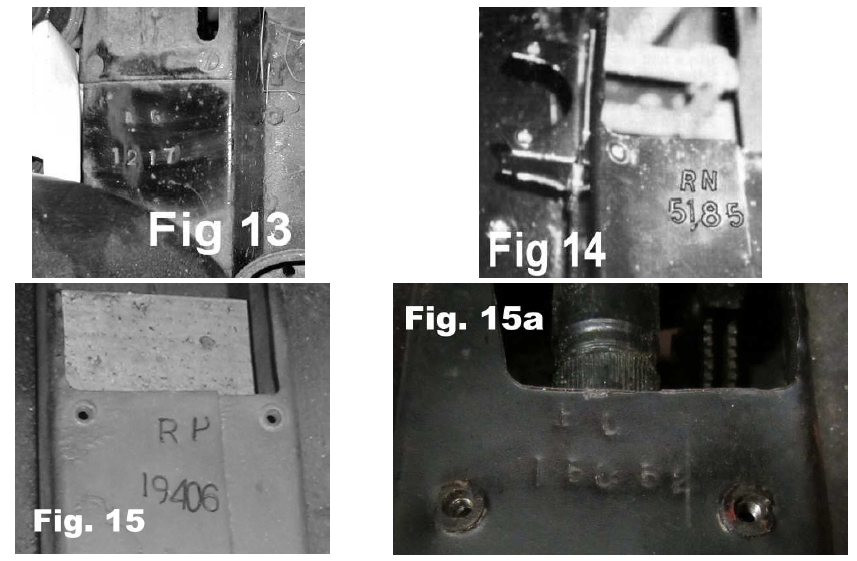The Austin Motor Company used a number of different ways to identify the vehicles. The Austin Seven Clubs’ Association produced a reference document called ‘Quote this Number’ which is available to see below.
NEW EDITION!!
The printed booklet ‘Identifying Austin Sevens’ is now available from Graham Baldock.
Car Number
The ‘Car No.’ was an Astuin Works Ledger number by which the factory or garage could identify all assembled cars after engines had been fitted,tested and passed.
The “Heritage” records known to survive are for just four sequences of cars:
| 31st Jan – June 1929 A8 Series | Chassis 77535-87433 | A8 101 – A8 9999 |
| June – Oct 1929 A9 Series | Chassis 87434 – 97332 | A9 101 – A8 9999 |
| March – Sept 1930 B1 Series | Chassis 107228 – 117126 | B1 101 – B1 9999 |
| Jan – May 1931 B3 Series | Chassis 127026 -136924 | B3 101 – B3 9999 |
Heritage Certificates can be requested from the British Motor Museum, Banbury Road, Warwickshire.
| A1 – 1922 | B1 – March 1930 | |
| A2 – May 1925 | B2 – September 1930 | |
| A3 – May 1926 | B3 – January 1931 | |
| A4 – February 1927 | B4 – May 1931 | |
| A5 – August 1927 | B5 – January 1932 | |
| A6 – April 1928 | B6 – June 1932 | |
| A7 – September 1928 | B7 – January 1933 | |
| A8 – February 1929 | B8 – June 1933 | |
| A9 – June 1929 | B9 – January 1934 | |
| B – October 1929 | C – June 1934 |
ARQ etc for the Jewel series from July 1934 at Chassis No. 249701
From July 1936 separate Car and Chassis Nos’ were dropped and the Chassis No. was the only reference number from the introduction of the New Ruby.
Cylinder Heads
Casting Number XL-845 used up to 1924 – 18mm plugs
Casting number XL 1253 used up to 1926 – 18mm plugs
Casting number 1A 38 used 1926 onwards – 18mm plugs
Casting number 9E1 made from Chromidium was fitted to unsupercharged EA models or (c 7 for supercharged EA models EB (65) and EK.
Car/Chassis/Engine Numbers
Please note some plates have been painted over or deliberately transposed to re-register a fraudulently acquired number or car.
The service plate was screwed to the early cars, as a numbered zinc disc, up to about A4- 4000, April 1927. Fig 1. It continued next as two plates vertically near the petrol tap on the bulkhead Fig 2, then the two plates moved to the inclined lip on the nearside scuttle. Fig 3. Sometimes these have been painted over or deliberately transposed to reregister a fraudulently acquired number or car, or simply to re-assemble a road-going vehicle from two or three basic elements. Fig 4 shows original and reproduction plates and the difference in style of letters and numbers, then Fig 4a a Ruby saloon.

Engine Number
Always easily found. Stamped into the crankcase at the front nearside (to read conveniently with the early chassis) and later duplicated near the rear offside oil pipe union. Always prefixed M (for Motor) except possibly on marine or stationary adaptations Figs 5, 6 & 6a or blank replacement if ex. works.

Chassis Number stamped on the Chassis
At first, this was stamped on the nearside rail, forward of the front engine mounting. Figs 7 & 8; then sometime in the late ’20s the works moved the numbering along the rail to just forward of the rear engine mounting, adding the Engine Number. Figs 9 & 10. In the early 30’s only the Chassis number was marked and located behind the rear engine mounting (this position is normally covered by the side/splash plate). Figs 9, 11 & 11a. Finally, from the mid. 30’s, a plate was attached by rivets to the offside rail below the starter. Fig 12.

Body Number
Always stamped on the top of the propshaft tunnel between the front seats. Figs 13, 14, 15 & 15a. As saloons and other bodies progressed after early tourers, a simple alphabetical prefix was added. Basically, Tourers were A .. ., Coupes were B …, Sports were E …., 2-seaters were P …, Saloons were R …; but with at least 50 derivatives.
 At first, the chassis rear cross member carried all three chassis, engine and body Nos, stamped into the nearside web, facing rearwards (Fig 16), but these numbers were discontinued about 1926.
At first, the chassis rear cross member carried all three chassis, engine and body Nos, stamped into the nearside web, facing rearwards (Fig 16), but these numbers were discontinued about 1926.
Very occasionally, a number has been found stencilled on the offside, e.g. Ch. No. 107577 of April 1930 (Mill’s book, ‘Original Austin 7’, p17 and also Purves’ Source Book, p118).
Rear Axle
All axles had their exact date, a foundry number and a ratio, but rust may have eroded these. Figs 17 & 18.

Electrical
Many starters and dynamos are month dated but of course are likely to be exchange units. One item that rarely failed was the cut-out/fuse box. Early ones had the bases stamped, then the smaller upper cover eg 6V ER 10 32 (October 1932). Fig 19 shows the base of an original coil – my cut-out covers were too corroded to provide a clear illustration.

Original article from the Grey Mag 1990A, Text 1990 and 2005
Author – Phil Baildon; reproduced and updated with his kind permission.
Additional notes and photographs, etc. E & O.E., by Sandy Croall in 2005, then Jim Blacklock, Registrar, in 2013.
Copyright ‘The Austin Seven Clubs’ Association’,


